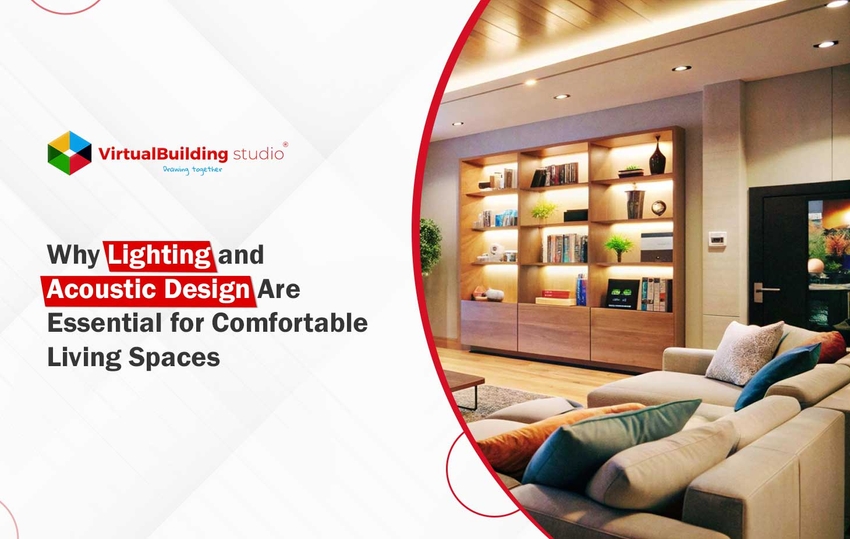
It’s More Than Just Looks
Imagine coming home after a long day in a dim fluorescent-lit office; your eyes have been having their share of strain, and you cannot muster energy anymore to put forth more effort. Now, picture attempting to unwind in your living room but getting interspersed with the constant traffic rumble sneaking through the walls. At some level, they show how much acoustics and lighting affect our experience of any space.
Great designers will consider these aspects, but communicating the intricacies of lighting and acoustics can prove hard when it comes to private residences. They are far from superficial beautifications on a home. Lighting and sound constitute health, productivity, and emotional well-being, and in turning, they really encompass how one sleeps, works, relaxes, and connects with the people in that particular home.
In this regard, design decisions by an architect for lighting and acoustics directly affect clients' satisfaction and living experience through time.
This article will:
- Deconstruct the specifications behind lighting and acoustic comfort.
- Describe their contribution toward healthier and sustainable homes.
- Present design tips towards helping architects in designing homes that feel like real sanctuaries.
The Impact of Light in Residential Comfort
Lighting is one of the most important yet underutilized design tools in the world of residential architecture. Lighting, beyond serve aesthetic purposes, can also manipulate physiology, mood, and how we function daily. For architects, carefully planned lighting strategies can add depth to the visual quality of the home and help improve the livability of the
Natural Lighting – The Basis of Our Well-being
- Appropriate exposure to daylight regulates circadian rhythms, improving sleep quality and mental health.
- Research suggests that exposure to daylight can increase productivity and lower levels of stress hormones.
- Architectural elements to consider: The orientation of windows, skylights, light shelves, and light glazing specifications.
Artificial Lighting - Layered for Versatility
- Ambient lighting is your base layer.
- Task lighting allows accuracy for reading, cooking, or your work-from-home zones.
- Accent lighting adds layer, alludes to texture and highlights focal points.
- Layering reduces important reliance on one light source, which cuts down glare and visual fatigue.
Energy Efficiency - Intelligent, Sustainable Choices
- LEDs have a high lumen output, require less energy and last many years longer than traditional sources.
- Smart systems allow homebuyers to increase or decrease brightness and color temperature, along with energy savings.
- For example, poorly lit interiors cause eye strain, often interfere with focus and create a dull environment, which detracts from both comfort and function.
Acoustic Comfort in Private Residences
Acoustic impacts not only atmosphere but also mental and physical health. For design firms, incorporating acoustic planning into design equips homes that feel properly private and restorative.
Noise Pollution – The Unseen Intruder
- Exterior stimuli: automobiles, airplanes, pedestrians, or urban activity.
- Internal sources: footsteps, HVAC systems, home appliances, and noise of the plumbing.
- Low-level noise above 35-40 dB will also affect sleep and decrease concentration.
Acoustic Design – Where Architecture Meets Science
- Materials: High NRC (Noise Reduction Coefficient) materials like acoustic gypsum board, mineral wool, and fabric panels possess high sound absorption capabilities.
- Layouts: Careful zoning of bedrooms away from noisy places such as garages or kitchens.
- Finishes: Carpets, curtains, and upholstered furniture reduce reverberation times.
Health Impacts – Beyond Annoyance
- Persistent exposure to noise elevates stress hormones.
- Sleep disorders cause fatigue, mood changes, and sluggishness.
- Both the elderly and children show increased vulnerability to poor acoustic environments.
Modern Solutions – Design-Integrated Noise Control
- Acoustic wall and ceiling panels.
- Doubled-glazed or laminated glass on the windows.
- Insulated walling and robust floor systems.
Takeaway: Thoughtfully conceived sound design allows houses to be sanctuaries—free of the noise of the external environment.
Why to Consider Lighting and Acoustics in Architectural Design
When you design lighting and acoustics together, you establish spaces that function, and they are also emotionally supportive. Their combined influence determines the mood and productivity of residential spaces and your overall mental health.
- Professional Environments: A home office, designed with glare-free, task lighting combined with acoustic insulation, keeps distractions at bay and enhances focus and efficiency.
- Relaxation Environment: Consider a living room, layering warm lighting with cushy furnishings like a rug, curtains, upholstered walls, etc. The warm, soft furnishings reduce reverberation, thus creating peace and relaxation.
- Mental Resourcing Impact: Balancing sensory input, the visual and auditory, lowers mental fatigue, reduces sleight stimulation, and facilitates a healthier way of living.
For architects, lighting and acoustics unified together create homes and residences that are holistic sanctuaries where aesthetics, comfort, and performance are integrated fully.
Practical Tips: Design Considerations for Modern Homes
Lighting and acoustic strategies should always be done at the beginning of the planning phase for design purposes. Lots of possible designs or solutions could be made to making these things more efficient, more comfortable, and more valuable to live in over the long term.
Even when working with existing houses, compromises could allow for some smart fixes to be undertaken to modify living conditions to facilitate healthier and more functional living areas.
Below, we have outlined some options that architects may suggest, and architects can use as design ideas.
Strategies for Immediate Implementation of Lighting
- Layer Lighting for Versatility: Incorporate ambient, task, and accent lighting to transform spaces for different utilization, like dining, working, and relaxation. Layering prevents reliance on a single source, reducing glare and providing greater visual comfort.
- Dimmer Switches To Operate: Installation of dimmers enables occupants to vary lux levels with activity. Low levels of illumination (approximately 150–200 lux) are suitable for relaxation, high levels (300–500 lux) accommodate productivity.
- LEDs with Adjustable Color Temperature: Tunable LEDs can be shifted from warm white (2700K) at night when relaxing to daylight (5000K-6500K) in the morning when energizing and focused on matching natural circadian rhythms.
- Maximize Natural Light: Architecture techniques such as the use of mirrors, light shelves, and reflective coatings improve daylight infiltration. Low-cost techniques such as cleaning windows also improve the quality of light.
- Blackout Curtains for Bedrooms: Critical to the management of both heat gain and light pollution, allowing uninterrupted sleep patterns.
Acoustic Strategies That Can Be Employed Immediately
Soft Surfaces for Absorption: Carpets, area rugs, heavy drapery, and upholstered furniture absorb more sound, lowering reverberation times (RT60) and increasing the audibility of spoken words inside buildings.
- Fill Gaps Around Openings: Weatherstripping of doors and windows also eliminates external noise intrusion. Small air leaks can also greatly reduce the acoustic performance.
- Strategic Layout as Buffers Against Noise: The placement of bookshelves, wardrobe pieces, or heavy furniture items next to party walls adds mass and damping, serving as effective sound barriers.
- Acoustic Panels and Ceiling Tiles: Inexpensive, architecturally diverse solutions that enhance sound absorption in home office, media rooms, and spacious living rooms. Panels with NRC ≥ 0.70 are very effective.
- White Noise Solutions: Installation of a white noise machine or fan can help obscure distracting environmental sounds to offer more serene sleep and work conditions.
Key Points: Architects can incorporate these options for better lighting and acoustic quality to improve the comfort of their residential clients and create a measurable improvement for health, energy use, and ongoing livability.
| Category | Solution | Details / Technical Notes |
|---|---|---|
| Lighting | Layered Lighting | Combine ambient, task, and accent lighting to avoid glare and create flexible, activity-specific illumination. |
| Dimmer Switches | Provide control over lux levels (150–200 lux for relaxation, 300–500 lux for productivity). | |
| Tunable LEDs | Adjustable color temperature: 2700K (warm white) for evening, 5000K–6500K (daylight) for daytime alertness. | |
| Maximize Natural Light | Use mirrors, reflective finishes, and light shelves; keep windows unobstructed and clean. | |
| Blackout Curtains | Essential for bedrooms to block external light and support circadian rhythm regulation. | |
| Acoustics | Soft Surfaces | Rugs, carpets, upholstered furniture, and curtains reduce reverberation time (RT60) and improve speech clarity. |
| Seal Gaps | Apply weatherstripping on windows/doors to minimize external noise leakage. | |
| Strategic Layout | Position large furniture or bookshelves on shared walls to act as sound buffers. | |
| Acoustic Panels/Tiles | NRC ≥ 0.70 panels or ceiling tiles enhance absorption in home offices or media rooms. | |
| White Noise Solutions | White noise machines or fans mask disruptive sounds, supporting relaxation and focus. |
Benefits of Lighting and Acoustic Design Beyond Comfort
The integration of light and acoustic strategies in the residential design process adds value to a client's space, and is more than a design touch. For architectural firms, emphasis on the added value from these interventions helps clients understand the return on investment from carefully considered design.
Increased Property Value
- Homes designed with maximum daylighting, layered artificial lighting, and acoustic comfort can have a higher value.
- Improvements such as double glaze windows, blackout systems and automatic lighting can distinguish a buyer's purchase decision, or carry resale value.
Sustainability and Energy Efficiency
- LED fixtures or adjustable lighting systems can use 80% less energy than traditional lamps.
- Acoustic insulation products can have improved thermal performance, resulting in lower HVAC loads and operational costs.
- Daylighting and acoustic performance are also critical aspects in green certifications such as LEED and WELL.
Resident Lifestyle Upgrade
- Balanced light improves circadian health, mood, and efficiency.
- Acoustic control alleviates stress, improves sleep quality, and relaxed states of being.
- The two of these will create spaces that are restorative, functional, and future forward.
Key Takeaway: Light and acoustic controls are more than comfortable features; they are design investments that optimize wellness, sustainability, and long-term ROI.
Conclusion
Lighting and acoustic comfort are not a luxury; these are vital for healthy, high-performing homes. Subpar lighting or an uncontrolled noise environment detracts from sleep, concentration, and well-being, while thoughtful lighting and acoustic strategies create homes that can truly be considered sanctuary spaces.
For homeowners, planning for these elements during renovation or new construction is beneficial for long-term livability, sustainability, and property value.
Virtual Building Studio presents an excellent option for architectural firms wanting to leverage experts in the BIM field who can help your firm put positive lighting and acoustic strategies into the residential projects they undertake, helping firms put together designs that exceed their clients' ambitions.




